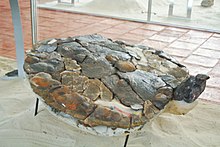| Leyvachelys | |
|---|---|

| |
| Scientific classification | |
| Domain: | Eukaryota |
| Kingdom: | Animalia |
| Phylum: | Chordata |
| Class: | Reptilia |
| Clade: | Pantestudines |
| Clade: | Testudinata |
| Clade: | †Thalassochelydia |
| Family: | †Sandownidae |
| Genus: | †Leyvachelys Cadena, 2015 |
| Species: | †L. cipadi
|
| Binomial name | |
| †Leyvachelys cipadi Cadena, 2015
| |

| |
| Paleogeography of Northern South America 120 Ma, by Ron Blakey | |
| Synonyms | |
| |
Leyvachelys is an extinct genus of turtles in the family Sandownidae from the Early Cretaceous (Late Aptian to Early Albian) of the present-day Altiplano Cundiboyacense, Eastern Ranges, Colombian Andes. The genus is known only from its type species, Leyvachelys cipadi, described in 2015 by Colombian paleontologist Edwin Cadena. Fossils of Leyvachelys have been found in the fossiliferous Paja Formation, close to Villa de Leyva, Boyacá, after which the genus is named. The holotype specimen is the oldest and most complete sandownid turtle found to date.
Fossils of a turtle found in the dinosaur-rich Glen Rose Formation of Texas, informally named Glenrosechelys brooksi, have been assigned to the same genus and type species.